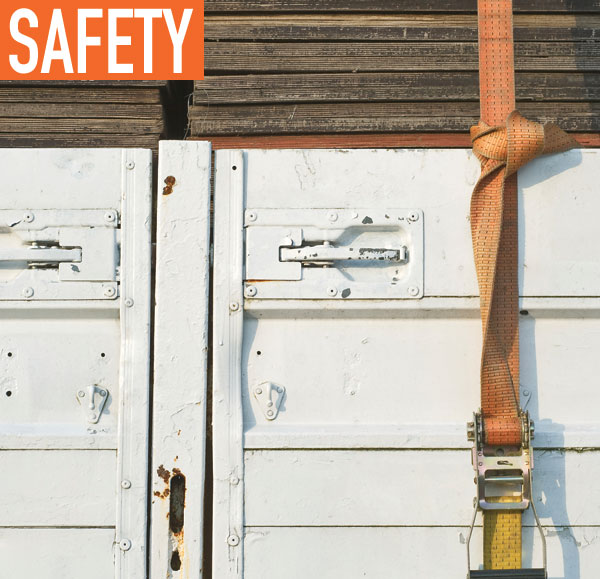Service-oriented fleets, as well as traditional transportation companies, rely on drivers to safely deliver equipment and materials. Often, these delivery sites are far less organized than brick-and-mortar freight docks. The risks are different and company training should prepare drivers accordingly.
Savvy companies know their vehicles are targets while on the road, because their insurance policies far exceed the average state minimum requirements applicable to passenger vehicles. They know their drivers not only risk a collision, but also injury while delivering at the jobsite. Educating your team on proper load securement and other safety procedures provides a simple way to mitigate risk during pickup and delivery.
PROTECTING ASSET
The number one way to protect your transportation company is adequate insurance. Insure the cargo, the transportation, and your drivers. As we all know, workers’ compensation statutes exist in virtually every state. The statute will operate to protect both your company and the employee driver, provided he or she is injured while on the job. The regulations provide some measure of protection from litigation, as well as the threat of a runaway jury award.
The second easiest way to protect your company is through training. Every company needs a training program tailored to their business. No single program will work for every company; however, generally speaking, training should cover proper securement procedures for your standard cargo, as well as key points for irregular deliveries. Training should discuss types of restraints, anchor points, and the dangers of a shifting load. Training should reinforce that drivers should check their load and its securement shortly after beginning a trip, and then every few hundred miles, at a minimum. Use a driver trainer to assist with your program during an orientation period that all drivers must go through, regardless of experience level.
THE PROPER RESTRAINT
Load shifting occurs when cargo is improperly secured or a restraint breaks, which permits the cargo to shift or slide during transportation. The results can be disastrous, including rolling trucks or otherwise toppling loads. Companies can address this risk by providing fixtures, such as wood, that block or brace the cargo to prevent movement. Educate the drivers on how to use these braces and about the significant increase in load failures when tie-downs or chains break. Remind your drivers that edge protection is required when using a tie down if the cargo could tear or cut the tie-down. For loose materials or weather-sensitive cargo, tarps are often needed and required.

USE COMMON SENSE
Finally, remind your drivers that there is no substitute for common sense. The Department of Transportation uses mathematical numbers to determine if a load is properly secured; however, your drivers should be able to look at a load, determine which directions the load might move during transport, and tightly secure it. Make time to spot-check your drivers and, again, use a system of driver trainers that are familiar with transporting your product.
Service-oriented transportation often requires deliveries to temporary jobsites that lack an organized team of loaders/unloaders or even a designated loading area. Delivery presents different risks than freight delivery to a freight dock. Drivers need to know the appropriate entry/exit points before they arrive at the location and may want to call ahead numbers to whomever is in charge onsite so they can obtain specific instructions. Make sure the driver knows where key personnel (including the customer in some cases) and workers are located within the jobsite before they arrive, and use flaggers, if necessary, to avoid blocking lanes of travel. Providing or requiring safety equipment, including florescent hard hats, reflective vests, and work boots is also highly advisable. Many jobsites will require this equipment, and your drivers should be prepared before they arrive. Your company should have policies that forbid cell phone use or using earphones while on the jobsite.
STAYING SAFE
Drivers are in the most danger when out of their vehicles during loading and unloading. Their attention is focused on the load rather than the surroundings. Particularly at shipping yards and construction sites, be sure to train drivers to constantly be aware of their surroundings. Specifically, they should look up and around for potential falling debris; never walk underneath a hoisted weight or load, walk around where the object would land, if it were to fall.
Finally, too many drivers try to shortcut proper loading procedures, particularly with flatbed or step-deck trailers. The temptation is to save a few minutes by not using a ramp. Injuries and equipment damage occur when drivers try to force lever the equipment onto the trailer. Make sure your drivers have proper ramps and are trained on how to use them.
Service-oriented companies face distinct risks within the industry, requiring a training and education policy that educates drivers how to properly obtain and secure a load. A smart company will communicate with its customers regarding pickup and drop-off points, as well as make sure their drivers know how to enter and exit a facility or jobsite. Encourage your customers to communicate with your drivers, as well as your company, to discuss improvements that can be made to safety. ![]()

ABOUT THE AUTHOR:
Peyton Inge is a senior associate at Chamblee Ryan Kershaw & Anderson in Dallas. He focuses his legal practice on commercial litigation and liability defense, frequently representing trucking companies in high-risk lawsuits involving claims of personal injury and wrongful death, as well as the defense of Carmack claims for damage to freight during transport.
__________________________________________________________________________
MODERN WORKTRUCK SOLUTIONS: Preview Issue
Did you enjoy this article?
Subscribe to the FREE Digital Edition of Modern WorkTruck Solutions magazine.
![]()




